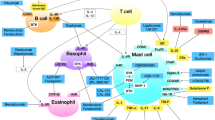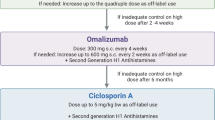Abstract
Purpose of review The management of chronic urticaria has substantially changed with the introduction of omalizumab to the treatment. Omalizumab did not only provide marked improvement in the treatment of the disease but also opened new horizons for the understanding of the pathways involved in the pathogenesis. But because of its requirement of hospital visits, cost, and only providing symptomatic relief, novel therapeutic targets are needed. Anti-IgE has gained a special interest given the high efficacy of omalizumab.
Recent findings New anti-IgE modalities include quilizumab, ligelizumab (QGE031), IgE-R419NFc3-4, MEDI4212, and DARPins. Biologicals that have been used off-label include TNF-α-antagonists and anti-CD20 treatment. There are ongoing clinical trials for IL-1 inhibitors, IL-5 inhibitors, and Bruton kinase inhibitors. As novel therapeutic targets are being studied, more questions will be answered about the pathogenesis and the ultimate goal of treatment will be moved forward to provide complete remission instead of symptomatic relief.
Summary This review focuses on biological treatments for chronic urticaria emphasizing particularly on the clinical efficacy, mechanism of action, and long-term treatment with omalizumab as well as other biologicals that have been used and are still under investigation for the treatment of this challenging disease.

Similar content being viewed by others
References and Recommended Reading
Papers of particular interest, published recently, have been highlighted as: • Of importance •• Of major importance
• Zuberbier T, Aberer W, Asero R, Bindslev-Jensen C, Brzoza Z, Canonica GW, et al. The EAACI/GALEN/EDF/WAO guideline for the definition, classification, diagnosis and management of urticaria. The 2013 revision and update. Allergy. 2014;69:868–87. This paper reviews the latest European guidelines on urticaria
Saini SS. Chronic spontaneous urticaria: etiology and pathogenesis. Immunol Allergy Clin N Am. 2014;34(1):33–52.
Weller K, Maurer M, Grattan C, Nakonechna A, Abuzakouk M, Berard F, et al. ASSURE-CSU: a real-world study of burden of disease in patients with symptomatic chronic spontaneous urticaria. Clin Transl Allergy. 2015;5:29.
• Guillén-Aguinaga S, Jáuregui Presa I, Aguinaga-Ontoso E, Guillén-Grima F, Ferrer M. Up-dosing non-sedating antihistamines in patients with chronic spontaneous urticaria: a systematic review and meta-analysis. Br J Dermatol. 2016; This paper is a metanalysis of updosing antihistamines.
Schulman ES. Development of a monoclonal anti-immunoglobulin E antibody (omalizumab) for the treatment of allergic respiratory disorders. Am J Respir Crit Care Med. 2001;164(8pt2):6–11.
Genentech, Inc. Xolair prescribing information 2014; available from: http://www.gene.com/download/pdf/xolair_prescribing.pdf
European Medicines Evaluation Agency (EMEA). Omalizumab (Xolair) summary of product characteristics (SmPC). [WWW document] 2014. URL http://www.ema.europea.eu
Kaplan A, Ledford D, Ashby M, Canvin J, Zazzali JL, Conner E, et al. Omalizumab in patients with symptomatic chronic idiopathic/spontaneous urticaria despite standard combination therapy. J Allergy Clin Immunol. 2013;132:101–9.
Maurer M, Rosen K, Hsieh HJ, Saini S, Grattan C, Gimenez-Arnau A, et al. Omalizumab for the treatment of chronic idiopathic or spontaneous urticaria. N Engl J Med. 2013;368:924–35.
Saini SS, Bindslev-Jensen C, Maurer M, Grob JJ, Bulbul Baskan E, Bradley MS, et al. Efficacy and safety of omalizumab in patients with chronic idiopathic/spontaneous urticaria who remain symptomatic on H1 antihistamines: a randomized, placebo-controlled study. J Invest Dermatol. 2015;135:925.
Corren J, Casale TB, Lanier B, Buhl R, Holgate S, Jimenez P. Safety and tolerability of omalizumab. Clin Exp Allergy. 2009;39:788–97.
• Zhao ZT, Ji CM, Yu WJ, et al. Omalizumab for the treatment of chronic spontaneous urticaria: a meta analysis of randomized clinical trials. J Allergy Clin Immunol. 2016;137:1742–50. This is an excellent metanalysis about the randomized clinical trials of omalizumab in CSU
Finlay AY, Kaplan AP, Beck LA, Antonova EN, Balp MM, Zazzali J, et al. Omalizumab substantially improves dermatology-related quality of life in patients with chronic spontaneous urticaria. J Eur Acad Dermatol Venereol. 2017; https://doi.org/10.1111/jdv.14384.
• Kaplan A, Ferrer M, Bernstein JA, Antonova E, Trzaskoma B, Raimundo K, et al. Timing and duration of omalizumab response in patients with chronic idiopathic/spontaneous urticaria. J Allergy Clin Immunol. 2016;137(2):474–81. https://doi.org/10.1016/j.jaci.2015.08.023. This paper gives idea on Omalizumab fast and slow responders
Gericke J, Metz M, Ohanyan T, Weller K, Altrichter S, Skov PS, et al. Serum autoreactivity predicts time to response to omalizumab therapy in chronic spontaneous urticaria. J Allergy Clin Immunol. 2017;139(3):1059–1061.e1. https://doi.org/10.1016/j.jaci.2016.07.047.
Giménez-Arnau A, Velasco M, Armario Hita JC, Labrador-Horrillo M, Silvestre Salvador JF. Omalizumab: what benefits should we expect? Eur J Dermatol. 2016;26(4):340–4. https://doi.org/10.1684/ejd.2016.2809.
Labrador-Horrillo M, Valero A, Velasco M, et al. Efficacy of omalizumab in chronic spontaneous urticaria refractory to conventional therapy: analysis of 110 patients in real-life practice. Expert Opin Biol Ther. 2013;13:1225–8.
Sussman G, Hebert J, Barron C, et al. Real-life experiences with omalizumab for the treatment of chronic urticaria. Ann Allergy Asthma Immunol. 2014;112:170–4.
Ghazanfar MN, Sand C, Thomsen SF. Effectiveness and safety of omalizumab in chronic spontaneous or inducible urticaria: evaluation of 154 patients. Br J Dermatol. 2016;175(2):404–6. https://doi.org/10.1111/bjd.14540.
Metz M, Ohanyan T, Church MK, Maurer M. Omalizumab is an effective and rapidly acting therapy in difficult-to-treat chronic urticaria: a retrospective clinical analysis. J Dermatol Sci. 2014;73(1):57–62. https://doi.org/10.1016/j.jdermsci.2013.08.011.
Metz M, Ohanyan T, Church MK, Maurer M. Retreatment with omalizumab results in rapid remission in chronic spontaneous and inducible urticaria. JAMA Dermatol. 2014;150(3):288–90. https://doi.org/10.1001/jamadermatol.2013.8705.
Sussman G, Hebert J, Gulliver W, Lynde CW, Yang WH, et al. Omalizumab retreatment of patients with chronic idiopathic urticaria/chronic spontaneous urticaria following return of symptoms. Primary results of the optima study Poster presentation. Helsinki: EAACI Congress; 2017. p. 17–21.
Staubach P, Metz M, Chapman-Rothe N, Sieder C, Bräutigam M, Canvin J, et al. Effect of omalizumab on angioedema in H1-antihistamine-resistant chronic spontaneous urticaria patients: results from X-ACT, a randomized controlled trial. Allergy. 2016;71(8):1135–44.
Maurer M, Schütz A, Weller K, Schoepke N, Peveling-Oberhag A, Staubach P, et al. Omalizumab is effective in symptomatic dermographism—results of a randomized, placebo controlled trial. J Allergy Clin Immunol. 2017;6749(17):30514–6. https://doi.org/10.1016/j.jaci.2017.01.042.
Metz M, Schütz A, Weller K, Gorczyza M, Zimmer S, Staubach P, et al. Omalizumab is effective in cold urticaria—results of a randomized, placebo controlled trial. J Allergy Clin Immunol. 2017;6749(17):30516–X. https://doi.org/10.1016/j.jaci.2017.01.043.
Maurer M, Metz M, Brehler R, Hillen U, Jakob T, Mahler V, et al. 2017. Omalizumab treatment in chronic inducible urticaria: a systematic review of published evidence. J Allergy Clin Immunol 24. 2017. https://doi.org/10.1016/j.jaci.2017.06.032
•• Kaplan AP, Giménez-Arnau AM, Saini SS. Mechanisms of action that contribute to efficacy of omalizumab in chronic spontaneous urticaria. Allergy. 2017;72(4):519–33. https://doi.org/10.1111/all.13083. This is an excellent paper on the mechanism of action of omalizumab in CSU
•• Sánchez-Borges M, Capriles-Hulet A, Caballero-Fonseca F, González-Aveledo L. Justification for IgE as a therapeutic target in chronic spontaneous urticaria. Eur Ann Allergy Clin Immunol. 2017;49(4):148–53. This paper nicely reviews the implication of IgE in urticaria and allergic diseases and gives important knowledge on anti-IgE therapy
Uysal P, Eller E, Mortz CG, Bindslev-Jensen C. An algorithm for treating chronic urticaria with omalizumab: dose interval should be individualized. J Allergy Clin Immunol. 2014;133:914–5.e2.
Kocatürk E, Aktan Ş, Atakan N, Bülbülbaşkan E, Erdem T, Koca R, et al. Türkiye Ürtiker Tanı ve Tedavi Kılavuzu-2016. TURKDERM. 2016;50(3):82–98.
•• Giménez-Arnau AM, Toubi E, Marsland AM, Maurer M. Clinical management of urticaria using omalizumab: the first licensed biological therapy available for chronic spontaneous urticaria. J Eur Acad Dermatol Venereol. 2016;30(Suppl 5):25–32. This is a very good review of omalizumab in urticaria focusing mainly on clinical usage
Clark JJ, Secrest AM, Hull CM, Eliason MJ, Leiferman KM, Gleich GJ, et al. The effect of omalizumab dosing and frequency in chronic idiopathic urticaria. J Am Acad Dermatol. 2016;74(6):1274–6.
Pinto Gouveia M, Gameiro A, Pinho A, Gonçalo M. 2017. Long-term management of chronic spontaneous urticaria with omalizumab. Clin Exp Dermatol. 42(7):735-742. https://doi.org/10.1111/ced.13173.
Casale TB, Scarupa MD, Holden M, Trzaskoma BL, Antonova E, Win PH. Study design, baseline and open-label results from XTEND-CIU: a phase IV, multicenter, randomized, double-blind, placebo-controlled study to evaluate the efficacy and safety of omalizumab through 48 weeks in patients with chronic idiopathic urticaria. J Allergy Clin Immunol. 2017;139(2):AB271–1.
•• Giménez-Arnau AM. Omalizumab for treating chronic spontaneous urticaria: an expert review on efficacy and safety. Expert Opin Biol Ther. 2017;17(3):375–85. Very good paper on the omalizumab and urticaria with the expert’s own experiences
•• Joshi S, Khan DA. 2017. The expanding field of biologics in the management of chronic urticaria. J Allergy Clin Immunol Pract. 2017. https://doi.org/10.1016/j.jaip.2017.05.018This paper nicely reviews biologicals for urticaria mainly focusing on omalizumab.
Ohanyan T, Schoepke N, Bolukbasi B, Metz M, Hawro T, Zuberbier T, et al. 2017. Responsiveness and minimal important difference of the urticaria control test. J Allergy Clin Immunol 2017. https://doi.org/10.1016/j.jaci.2017.04.050
•• Boyman O, Kaegi C, Akdis M, Bavbek S, Bossios A, Chatzipetrou A, et al. EAACI IG biologicals task force paper on the use of biologic agents in allergic disorders. Allergy. 2015;70(7):727–54. This paper reviews recent biologicals for allergic diseases
Arm JP, Bottoli I, Skerjanec A, Floch D, Groenewegen A, Maahs S, et al. Pharmacokinetics, pharmacodynamics and safety of QGE031 (ligelizumab), a novel high-affinity anti-IgE antibody, in atopic subjects. Clin Exp Allergy. 2014;44(11):1371–85.
Harris JM, Cabanski CR, Scheerens H, Samineni D, Bradley MS, Cochran C, et al. A randomized trial of quilizumab in adults with refractory chronic spontaneous urticaria. J Allergy Clin Immunol. 2016;6749(16):30631–5. https://doi.org/10.1016/j.jaci.2016.06.023.
•• Kocatürk E, Maurer M, Metz M, Grattan C. Looking forward to new targeted treatments for chronic spontaneous urticaria. Clin Transl Allergy. 2017;7(1) https://doi.org/10.1186/s13601-016-0139-2. This paper focuses on all upcoming treatments for chronic urticaria
•• Navinés-Ferrer A, Serrano-Candelas E, Molina-Molina GJ, Martín M. IgE-related chronic diseases and anti-IgE-based treatments. J Immunol Res. 2016;2016:8163803. https://doi.org/10.1155/2016/8163803. Very good review on anti-IgE treatments
Pennington LF, Tarchevskaya S, Brigger D, et al. Structural basis of omalizumab therapy and omalizumab-mediated IgE exchange. Nat Commun. 2016;7:11610.
Incorvaia C, Riario-Sforza GG, Ridolo E. IgE depletion in severe asthma: what we have and what could be added in the near future. EBioMedicine. 2017;17:16–7. https://doi.org/10.1016/j.ebiom.2017.02.023.
Nyborg AC, Zacco A, Ettinger R. Development of an antibody that neutralizes soluble IgE and eliminates IgE expressing B cells. Cell Mol Immunol. 2016;13:391–400.
Kim B, Eggel A, Tarchevskaya SS, Vogel M, Prinz H, et al. Accelerated disassembly of IgE receptor complexes by a disruptive macromolecular inhibitor. Nature. 2012;491:613–7.
Lenormand C, Lipsker D. Efficiency of interleukin-1 blockade in refractory delayed pressure urticaria. Ann Intern Med. 2012;157(8):599–600.
Bodar EJ, Simon A, de Visser M, van der Meer JW. Complete remission of severe idiopathic cold urticaria on interleukin-1 receptor antagonist (anakinra). Neth J Med. 2009;67(9):302–5.
Sand FL, Thomsen SF. TNF-alpha inhibitors for chronic urticaria: experience in 20 patients. J Allergy (Cairo). 2013;2013:130905.
Bangsgaard N, Skov L, Zachariae C. Treatment of refractory chronic spontaneous urticaria with adalimumab. Acta Derm Venereol. 2017;97:524–5.
Arkwright PD. Anti-CD20 or anti-IgE therapy for severe chronic autoimmune urticaria. J Allergy Clin Immunol. 2009;123:510–1.
Chakravarty SD, Yee AF, Paget SA. Rituximab successfully treats refractory chronic autoimmune urticaria caused by IgE receptor autoantibodies. J Allergy Clin Immunol. 2011;128:1354–5.
Mallipeddi R, Grattan CE. Lack of response of severe steroid-dependent chronic urticaria to rituximab. Clin Exp Dermatol. 2007;32:333–4.
Asero R, Cugno M, Tedeschi A. Eosinophils in chronic urticaria: supporting or leading actors? World Allergy Organ J. 2009;2(9):213–7. https://doi.org/10.1097/WOX.0b013e3181bb965f.
Magerl M, Metz M, Terhorst D, et al. Benefit from mepolizumab treatment in a patient with chronic spontaneous urticaria. Poster presented in EAACI congress, 2017, Helsinki.
Katsumoto T, Winter H, Kotwal S, et al. Safety, pharmacokinetics, and biomarker profile from phase 1 clinical trials of healthy volunteers treated with GDC-0853, a highly selective reversible oral Bruton’s tyrosine kinase (BTK) inhibitor. Abstract presented in 2016 ACR/ARHP Annual Meeting.
Author information
Authors and Affiliations
Corresponding author
Ethics declarations
Conflict of Interest
Emek Kocatürk has received honoraria for scientific advice or consultancy from Novartis.
Human and Animal Rights and Informed Consent
This article does not contain any studies with human or animal subjects performed by any of the authors.
Additional information
This article is part of the Topical Collection on Urticaria and Atopic Dermatitis
Rights and permissions
About this article
Cite this article
Kocatürk, E. Role of Biologics and Future Perspectives in the Treatment of Urticaria. Curr Treat Options Allergy 4, 428–437 (2017). https://doi.org/10.1007/s40521-017-0145-1
Published:
Issue Date:
DOI: https://doi.org/10.1007/s40521-017-0145-1




